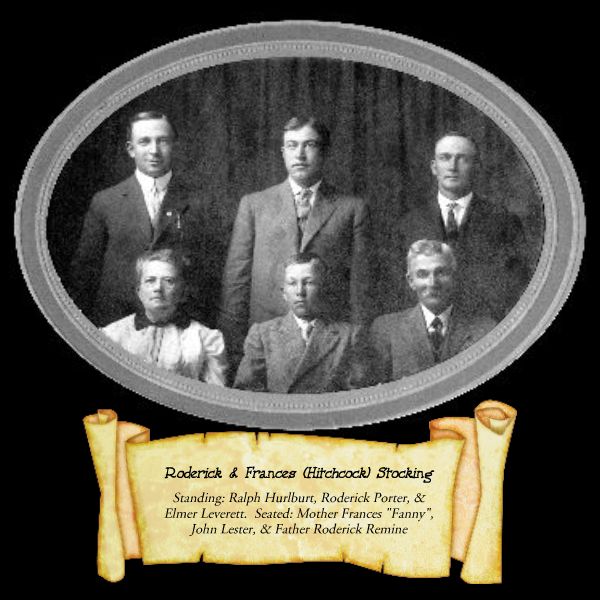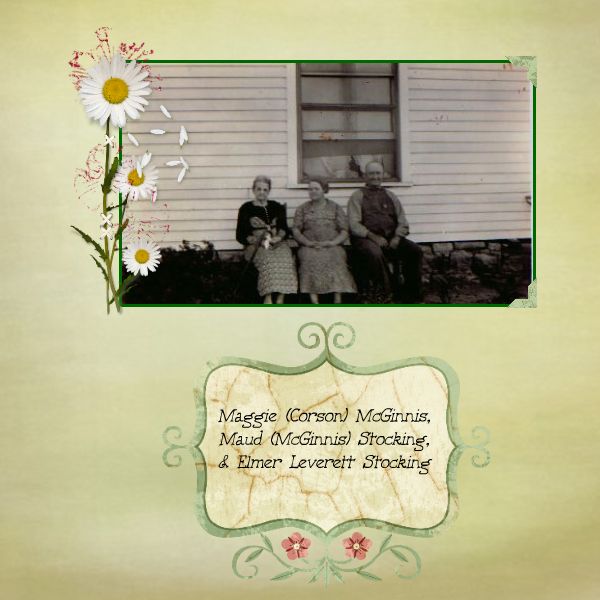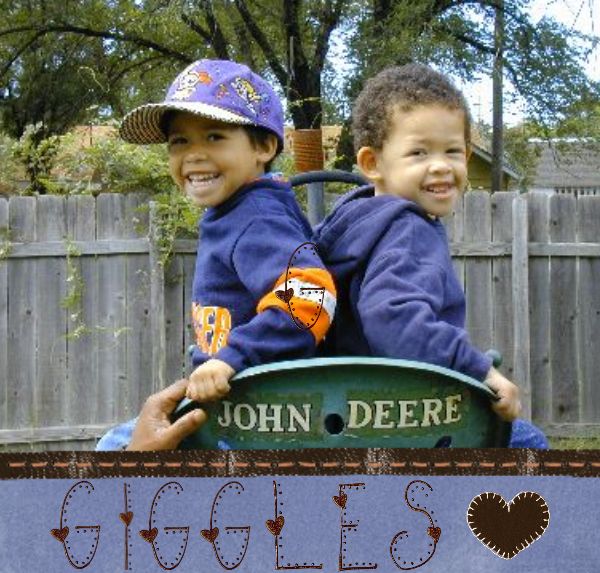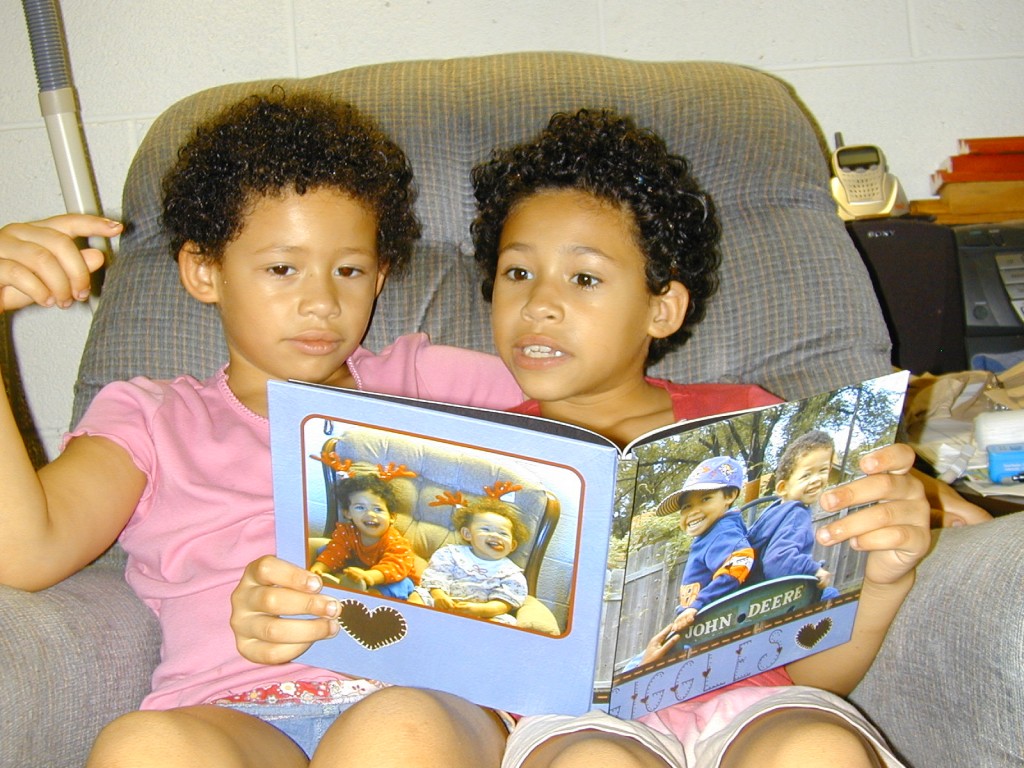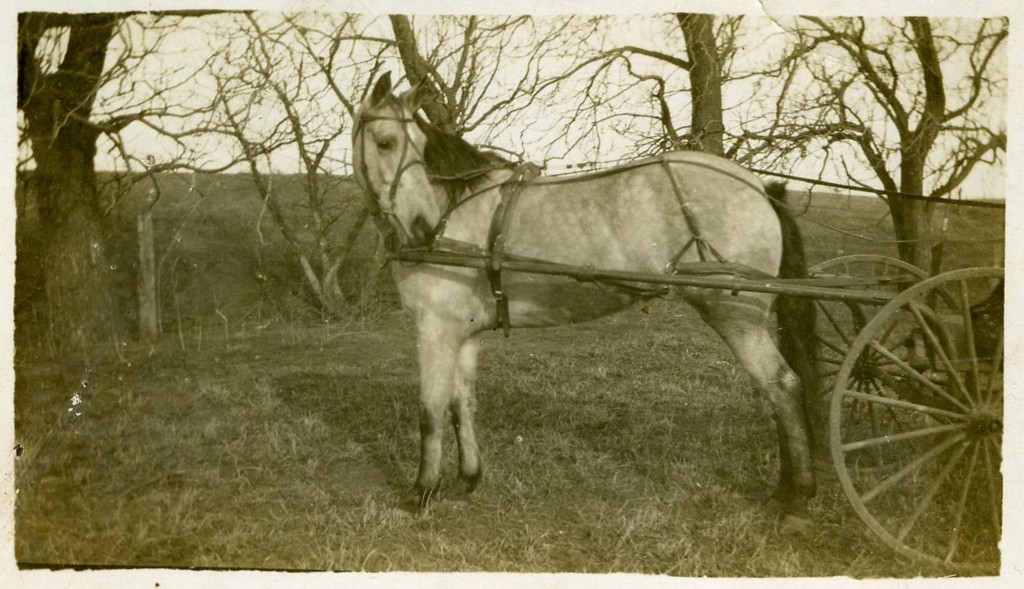Posts Tagged ‘vintage photographs’
Carnival Of Genealogy – Scrapbooking my Family History One Page at a Time
by Sherry Stocking Kline
01 August 2010
Off and on for several years, I’ve tried to get started scrapbooking and journaling my photographs. But it takes a lot of room to gather it all up, and spread it all out.
And I seem to be one of those people who have to change background papers and photographs over and over (and over) till I finally find the combination that I like. Takes hours. (And usually two more trips to the scrapbook store!)
Then I found digital scrapbooking with a Twitter friend on-line.
So, instead of cutting up my photographs, and then wishing they were a different shape and size, or worse yet, wishing I had never cut them up at all, now I can digitize photos, crop, re-size, and re-shape to my heart’s content, leaving the originals alone.
I love it!
Below are some of the 12 x 12 scrapbook pages for my family history book that I’ve created. First, is the page for my great-grandparents, Roderick Remine and Frances “Fanny” (Hitchcock) Stocking and their four sons.
My grandfather is standing on the far right, Elmer Leverett. He passed away before I was born, and I never got to meet him. (I sooo wish that I had been able to get to know him.)
The photo below here is my great-grandmother, Maggie (Corson) McGinnis and her daughter and son-in-law, Maud and Elmer Stocking.
It looks to me like they are sitting on the east side of Maud and Elmer’s home near Mayfield, Kansas. Maud and Elmer’s home was on their farm on the NW 1/4 of 18-32-2W, where they had a quarter section of land. (160 acres). Later, my parents bought this farm from Maud and Elmer and I grew up here as well. The house burned down several years ago.
The photograph below is of my dad’s parents and his siblings. What a great photograph! (I wish I knew when it was taken!!) I really like the burnt sienna colored paper below with it’s hints of other shades, and I added just a few “starbursts” to it to ‘gussy’ it up a little.
My grandfather is seated on the left and my grandmother is seated on the right. My father, Harold Stocking, Sr., is standing on the back row, third from the left.
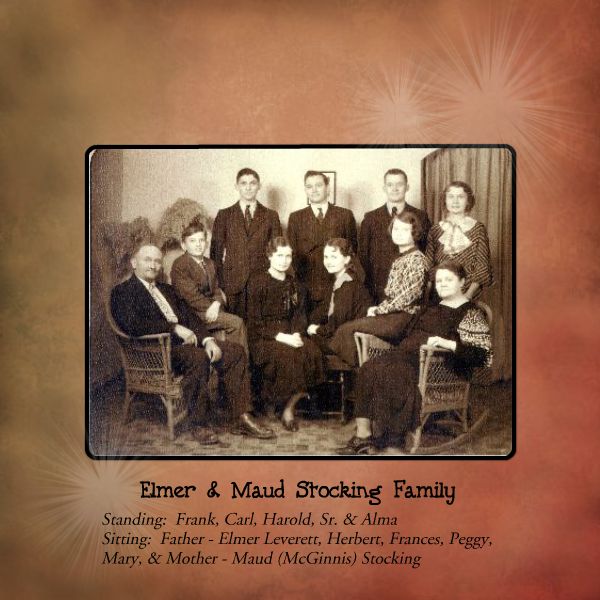
The Elmer Leverett and Maud (McGinnis) Stocking Family. Standing: Frank, Carl, Harold, Sr., and Alma; Seated, Father Elmer Leverett, Herbert, Frances, Peggy, Mary, and Mother Maud.
While researching and preserving history is very important to me, my scrapbooking is not all about preserving the past, it’s also about preserving and enjoying the present, too, and being able to enjoy it again and again for the future.
Below is the cover from “Giggles”, an 8 x 8 scrapbook that I created this summer for my two darling little granddaughters. There are several of my favorite photos and fun times that we’ve had in the past few years, and the book is a favorite with the girls as well. I also think it will help them remember all the fun times that we’ve had!
Below is a photo of the girls reading their very own Storybook Scrapbook!
Currently I am using a Family Photo Tree template at www.TurnMemoriesIntoBooks.com to create a 12 x 12 scrapbook page of our family tree. I am also working on a Storybook for my mother, who is nearly 99 years old, so I’m working with some really neat old photographs, and preserving some fun stories!
Astronaut Cousin Makes History Today – Dottie Metcalf-Lindenburger
by Sherry Stocking Kline
05 April 2010
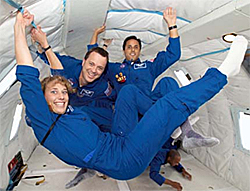
Dorothy Metcalf-Lindenburger and fellow educator astronauts, Richard Arnold and Joseph Acaba - NASA photo
Usually when our ancestors, or even ourselves become a bigger part of history we’re just not aware of it at the time. It’s when the history books write the story and we read it later that we know, even if they did not, that they helped shape the events of that time.
But today, my cousin’s daughter, Dorothy Metcalf-Lindenburger, went up in space and for all time she became one of those whose names go down in history books, one of those brave and courageous ones who went into outer space and helped shape history.
Dorothy is one of three educator astronauts, and she will see our world, our earth, in a perspective we can only try to imagine! Just think of what she can share with her students, and those she will speak to in the future.
Dorothy told me that her job will be on the flight deck as the flight engineer for ascent and entry, and she will be flying the Shuttle’s robotic arm, helping move 18,000 pounds of science and engineering equipment.
Dottie said that during the spacewalks, she will be inside as the crew member leading them through the spacewalk.
The launch this morning (Praise the Lord!) was picture perfect, and for the next 13 days, Dottie will be doing what she’s trained for the past several years to do, and those of us here, friends and family will pray for her safety and watch their mission on www.NASA.gov and our local television channels!
Other Related Links:
Denver Channel News – Dottie’s parent’s interview from Ft. Collins, CO
Video: http://www.thedenverchannel.com/video/22747395/index.html
Article: http://www.thedenverchannel.com/news/22746823/detail.html
Wikipedia: http://en.wikipedia.org/wiki/Dorothy_Metcalf-Lindenburger
Runner’s World Article: http://www.runnersworld.com/article/1,7124,s6-243-410–13448-0,00.html#
Wellington Daily News: http://www.wellingtondailynews.com/features/x1336921704/Astronaut-has-Sumner-County-ties
Other Related Posts:
Follow the STS-131 Astronauts on Facebook
What’s Going Up in Space with Dottie Metcalf-Lindenburger
Wordless Wednesday – Constantine “Tom” Breneman’s Horse
by Sherry Stocking Kline
February 3rd, 2010
Several last week asked me to post the close-up of Great-Grandpa Constantine ‘Tom’ Breneman’s horse (I meant to do that last week along with last week’s photo!) so here is my follow-up post!
Like many of you, I love horses, and this is a fine looking horse. I’m guessing he was a dapple gray with darker mane and tail, but I suppose he might have been more of a cream color with dark mane and tale, like Dale Evans Rogers’ horse “Buttermilk”.
So many questions that I have with last week’s photo and this. First and most important:
What was his name? (the horse’s I mean)
What breed(s) was/were he? In last week’s photo he looks to be a fairly tall horse. Any horse lovers want to hazard a guess?
Did Great-Grandpa ride him, or was he strictly a buggy horse?
What year were these pictures taken? I wonder? I know with some detective work, I can narrow this down considerably.
Where was Great-Grandpa headed looking so spiffy? Or was he just out for a drive? Nearly all pictures we have of him, he is dressed in a suit, but in last week’s photo, he looks particularly spiffy.
I asked mom again this week “Was Grandpa a farmer?”
I knew that he lived on at least two different farms here, and she said that he did farm, but he really was more of a blacksmith, and did blacksmith work, rather than doing much farming.
His son, Otto or “Ott” as he was called, followed in his footsteps and had a blacksmith shop in Mayfield, Kansas. Those pictures are in a different box, but I will locate them and share here.
Neat! I just love old photos, especially with horses!
Great-Grandpa Breneman was a Civil War veteran, but I’ve never seen a photograph of him in uniform. I hope someday we run across one.
Related Posts:
Constantine Breneman and His Buggy Horse
Salinda E. (Rose) Breneman – Photograph Constantine’s wife, Salinda, and her tombstone. Salinda and he divorced in later life.
Too Young to Die – Photo of Constantine’s son Albert Breneman, his siblings, and another photo of Albert’s tombstone. Albert was killed in a Motorcycle Accident.
Can You Salvage Damaged Photographs?
By Sherry Stocking Kline
published in the Wichita Eagle’s “Active Life” magazine in November 2005
If disaster strikes, whether it’s Hurricane Katrina, your water heater sprung a leak, or your photographs have water and smoke-damage from a fire, don’t make the trash your first destination of choice for the remains.
Sometimes, even wet, stuck together photographs can be salvaged, but you have to act fast.
“A lot depends on the circumstances,” said Darrell Garwood, preservation officer, library archives division, Kansas State Historical Society, “There is a lot of dirt and contaminants in flood water,” Garwood said, “If they have been in water, especially dirty water longer than 48 hours they may not be able to be re-claimed.”
A lot also depends on what type of photographs are damaged. Are they fairly modern? Are they old? One-of-a-kind? Hand-tinted? What kind of paper are they on?
Before you do anything, you need to know what kind of photographs you are dealing with, and it may be necessary to consult a professional for help. To help you determine what kind of photographs you can safely repair yourself, or if you have no choice but to attempt the repair yourself, there are books, such as “How to Save Your Stuff From a Disaster” by Scott Haskins, and websites such as Northeast Document Conservation Center, www.nedcc.org, and the Kansas State Historical Society’s website at www.kshs.org, (click on preserve) can help you determine what kind of photographs you have, and how best to preserve them.
According to Gary Albright, senior paper/photograph conservator, Northeast Document Conservation Center, there are a number of different photographic processes, and while some photographs can be immersed for a day or more and still be restored, others will be completely ruined by a just a few minutes of water exposure.
“Time is of the essence: the longer the period of time between the emergency and salvage, the greater the amount of permanent damage that will occur,” Albright said.
Haskins stated that it’s best to consult a professional who can deal with the photographs without adding to the damage, especially if you have old or vintage photographs.
Wet photographs should always be a priority. Albright said that wet photographs should be air dried or frozen as quickly as possible to prevent mold damage. (Yes, he really did say frozen.)
If the photographs are still wet, it’s best to put them in clean, cool water, distilled water. Change the water often to make sure the water stays clean. Do not use bleach, detergent, fungicide or disinfectants. Do not touch, rub, scrub, or try to force stuck-together photographs apart. Handle them by the edge only, preferably with a blunt, clean pair of tweezers.
Drain excess water off the photographs, and lay them out flat, and separated, on clean, lint-free material to dry. Do not use newspapers. Negatives should be hung up by the edges to dry vertically. Circulate the air the help speed up the drying process and to prevent mold. Do not use a heater.
Can’t deal with them right away? Freeze any photographs that cannot be cleaned and dried within 72 hours.
If they are already wet, rinse off any dirt, mud, etc., separate photos or groups of stuck together photographs with wax paper, put them into zip lock freezer bags and put them in the freezer. Do NOT stack anything on top of them.
If your photos are damaged, you still may be able to scan them at 300dpi or better, and use image editing software such as Adobe Photoshop or Corel’s Paint Shop Pro to repair copies of your damaged photographs. You can use that new, digital copy to make new photographs.
Garwood stated that prevention is the most important thing, and Garwood agreed.
“Address prevention first,” Garwood said, “store them properly and avoid basement storage because basements are always the first thing to flood in a house.”
After prevention, Garwood suggested that you spend a little time in disaster preparedness. Know where your photographs, family letters, video tapes, DVD’s, and important papers are, so you can go right to them for a speedy recovery should it become necessary.
If possible, Garwood said, have back-ups and replacements.
“Make this part of your emergency preparedness plan, and remember that your papers and photos are not as important as yourself,” Garwood said, “People should always come first in a disaster.”
2009 Author’s Suggestion: Before freezing or beginning any restoration attempts, consult with professionals if at all possible.
This article idea came to mind following Hurricane Katrina, and the tornado that struck the Haysville, Kansas area. We drove through the tornado devastation where houses were turned into matchsticks, and papers and pictures were blowing in the wind. I realized that after life and limb were safe, it was the thought of losing my photographs that bothered me most if we were to be struck by a tornado.
Photographing Your Family History
by Sherry Stocking Kline
Wichita Eagle’s June 2001 “Active Life”
When Tammy Pontious’s great-grandchildren look at her family history scrapbook many years from now, Pontious doesn’t want them to see stiff, posed photos of people in their Sunday best clothes. She wants them to be able to see what they were like when they were working and playing.
“The key is to carry your camera with you,” said Pontious, who keeps her camera handy and often carries it along when she drives her daily school-bus route. “You’ll have missed opportunities if you don’t.”
Bob McCreary, who co-owns Scrapbook Garden, www.scrapbookgarden.com, with his wife Kathy, agreed. Many people keep one of the “point-and-shoot” or disposable cameras that take remarkably good photographs handy, said McCreary, adding that for a clearer photo with a point and shoot camera, you must aim the focal point of the camera at someone in the group and not at the background.
Because photographing people in front of a simple background is often better, Pontious looks at the background before snapping and decides if it will help tell the story or just clutter up the photograph, though with today’s digital software, it’s fairly simple to crop out, blur, or even replace an unwanted background.
Close-up’s are great for people photos and eliminating distracting backgrounds, but check your camera’s manual before taking one, advises Kodak.com, as some cameras cannot focus closer than four feet from the subject. When using a flash, you need to check your flashes’ useful range as well. For many cameras, anything past 10 to 12 feet is a dark blur, as any concert goer can attest to after snapping photo after photo only to get home with photos of a shiny bald head about eight feet in front of them.
Pontious, who calls herself “a picture fanatic,” said you need to take lots of photographs.
“You just can’t be stingy with the film,” Pontious said, “for $8.00, you’ll probably come up with two or three photos that you’re in love with.”
For sharp, clear photographs, hold the camera steady, and try Pontious’ technique of visualizing the photo before gently pressing the shutter button. Pontious said she also tries a variety of different and unique angles, works to capture candid facial expressions, and likes to catch her family’s silhouettes in profile shots.
Pontious also ‘stalks’ the wildlife on their river farm, catches her dogs in silly poses, snaps her mom relaxing on the porch swing, and her husband and son while they work, hunt, and fish.
“That’s our lives,” Pontious said. Our descendants may say, “look what great-grandpa did back in those days.”
“You know the old saying about 1000 words? There is a lot of information that finds its way into a photo almost by accident, and sometimes it becomes significant to us later.” McCreary said.
“It’s candid shots of people doing things that tell the story of our lives,” McCreary said, “if Uncle Ralph was a farmer – take a photo of him on his combine. If someone hunts or fishes a lot get a photo of the big catch.”
To avoid that squinty-eyed look outdoors, photograph people on overcast days or in the shade using fill-in flash to highlight faces and chase away the shadows. Pontious said her favorite time of the day to take outdoor photographs is in the early morning or late afternoon, and said that she also likes to photograph subjects using the warm, natural lighting near a window.
“I just don’t like what I end up with at high noon,” Pontious said, “the photos all end up looking washed out.”
Pontious said that she looks for little situations and happenings, but she also works to create photographic events.
How does she do that? She sets up fun events for people to enjoy. One event that yielded some favorite photographs was a tea party she held for several laughing and giggling young cousins while she sat the corner of the porch “click, click, clicking away.”
McCreary said that while you are capturing your family in photographs, don’t forget to photograph your home(s), inside and out, and your yard, farm, barns, and outbuildings that are a part of your life today, and may be only a memory someday.
Pontious treasures the family resemblances she sees in the photographs of grandparents that died before she was born. She said that many of their photographs have been passed down from one person to another, from one generation to another, from trunks to attics, and came on covered wagons from there to here. She feels she is handing down a family history treasure to her son Dallas.
“A photo can tell you everything in the world,” Pontious said, “emotions, social status, whether they were rich or poor, lifestyle, facial features, looks and personality. What I would hope,” Pontious said, “is that it will tell them my values, hopes, dreams and what I accomplished.”
Someday she hopes that her descendants will look at her family history book and read the anecdotes, stories, and poems that are woven throughout, and will choose to preserve it, and hand it down again.
“Who knows where they’ll go in my son’s journey,” Pontious said.
Garage Sale Photos
by Sherry Stocking Kline
August 30, 2009
Written for FamilyTreeWriter.com after finding a family’s photographic treasures in a yard sale….
Call me crazy, but I love to garage sale. Go to them. Not have them.
So one lazy Friday afternoon when I was on my way to somewhere else I spotted a yard sale, slammed on the brakes, jumped out of the car, and went over to see if there was anything I couldn’t live without.
Not much. But there among the mismatched glasses and old pillow cases was a box of photographs with $2.00 written on the box flap.
I looked at the folks holding the yard sale, and trying not to sound like they’d just put a price tag on one of their children, I asked, “You’re selling your photographs?”
“No,” they answered, “they were here when we moved into the house.”
“Oh,” I answered, and feeling better I thumbed through the photographs. Some were old, maybe even early 1900’s old. Some appeared to have been taken in the 1930’s and judging by the clothes, crew-cuts, and cars, they seemed to continue up through the 50’s and 60’s.
Naturally, most were without names.
I walked around, browsed the other tables, but that box kept calling my name. Honest, it just pulled me back to it.
No matter how good or bad, my family photographs are treasures, bits and pieces of our lives, snapshots of our memories. This was someone else’s box of memories, someone else’s babies, someone else’s high school graduation, and someone else’s vacations. Surely somewhere there was someone who would be glad to have them back.
I started to pick up the box, all the while muttering under my breath, “You don’t have time,” “You may not find the family,” and “You’ve got enough to do preserving your own family history.”
But I’m pretty good at playing devil’s advocate, too. “Remember how you nearly cried when that elderly third cousin on your mom’s side that you just located told you she’d thrown her own family photos (your own family photos, too) away?” “Remember how excited you were when another new-found cousin gave you a photograph of your great-grandparents and you saw their faces for the first time.”
Then, my final winning argument, “if you can’t find the family(s) you can always send the photos to DeadFred.com, a website for ‘orphan’ photographs, as well as a place to upload your own ancestors.
“I’m a genealogist,” I said, explaining that I would like to take them and find their family.
“Do you have any idea who these belong to,” I asked. And that’s when the lady brought out the high school autograph book she found among the photographs and let me go through it. A few had signed their first and last names (a genealogist’s dream) and one or two included the city, state, and date, “Senior 1936” and “Eads, Colorado.” Eureka! Helpful clues.
So that did it. I was hooked and reeled in.
Ever the bargainer, I asked if they would take a dollar for it.
“Sure,” they said. I had a plan and a fall-back plan if I couldn’t find the family. So after I copied the information from the autograph book onto a raggedy envelope I had in my purse, I packed up the box, brought it home, and set about planning my next move.
